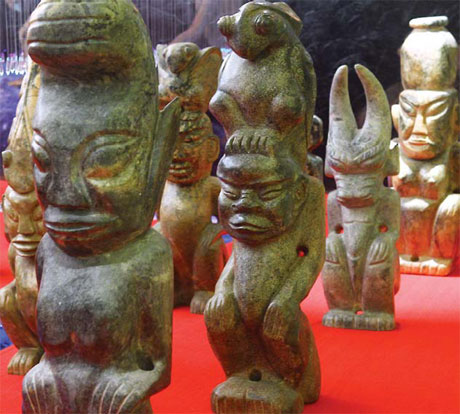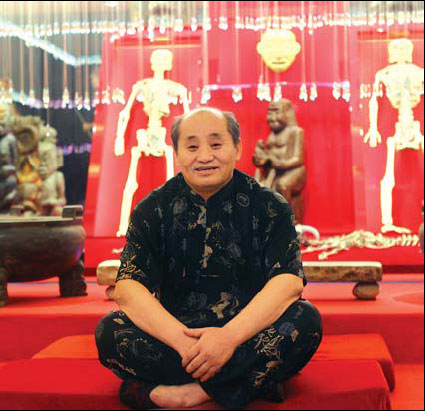|

The ancient jade carvings make the museum a fascinating place to visit in the city. Photos by Zou Hong / China Daily |
|

Huang Kangtai, who calls himself a "non-official archaeological exploration collector", has spent 37 years collecting more than 30,000 jade artifacts. Photos by Zou Hong / China Daily |
Beside a famous gourmet street north of the Fourth Ring Road, which is crowded every day of the week, stands a mysterious building.
Unlike the nearby noisy, busy street, the Museum of Loongtan Human and Humanities seems to be in suspended animation, with hardly any visitors.
Reading the introduction on the wall outside, you will discover the museum is dedicated to jade. But if you are expecting ostentatious handicraft products, you'll be disappointed. On entering, the first sight that greets you is the life-size jade skeletons of a man and woman.
|

Three ancient jade sculptures show the beauty and diversity of art on display. |
This 8,000-square-meter private museum contains more than 20,000 pieces of ancient jade, alleged to be between 5,000 and 30,000 years old.
It is a strangely fascinating place to visit for a day away from the office.
But, compared with the museum, its owner is even more remarkable.
For the love of jade, Huang Kangtai, who calls himself a "non-official archaeological exploration collector", has spent 37 years collecting more than 30,000 jade artifacts.The jade displayed in the museum is only part of his collection.
Huang was born in 1955 into an ordinary family in Shenyang, Liaoning province.
He did not finish primary school and did not know what he would do until, by chance, he found a small piece of dragon-shaped jade when he was in the military at the age of 19.
Since then, his love of jade has even resulted in him being taken to the morgue twice.
The first incident happened when he was only 19. He had a fight with several boys over a piece of jade and was fiercely beaten. The scars left on his head are still clear.
The second incident occurred during an expedition. He fell off a hill and lost consciousness for a whole day. When he woke in the morgue and sat up, all the people present were scared away. But even these events have not diminished his love of jade.
Most of his collection was found to the north of the Great Wall, where the Hongshan culture, one of the most ancient cultures in the world, dating back 5,000 years, existed. Hongshan culture is symbolized by jade carvings; especially dragon-shaped ones.
"I just got the sense they are there and I could usually find thousands of pieces in a year," he said.
Huang sees it as his destiny to collect jade, even though he has suffered a lot pursuing it.
"I am nothing like ordinary collectors," he said. "I make expeditions to locate first-hand materials, which in some cases, can mean risking my life."
Despite having no academic background, Huang says that his jade is evidence of the origin of human civilization. Though not officially recognized, Huang remains convinced of his theory that China is the origin of all civilizations, with a history dating back 30,000 years.
The majority of his collection is dragon-shaped jade carvings. In fact, Huang is even more passionate about dragons than jade. He was really upset when this symbol of China did not become the mascot for the Beijing Olympics.
"Unlike the image of dragons in Western cultures, Chinese dragons have a snake's body with no wings, and breathe water to form rain instead of fire," he said. "I want to change the Western world's fear of dragons and let them realize we are all 'descendants of the dragon'."
Huang said the dragon is the symbol of the country being integrated into one nation, because it combines the characteristics of nine different animals, which are all totems of different tribes.

Huang's wife has been married to him for 23 years. The only date they have ever had was watching the film Titanic, when he fell asleep 10 minutes after the movie started. But she said she loves him still for his integrity.
The museum has hardly any visitors partly because of its high ticket price - 300 yuan per person. Many people have tried to persuade Huang to lower it to attract more people, but he refuses, saying the money is not that much to venerate our ancestors.
Huang said the museum costs him 20 million yuan each year just for rent alone and that the daily operating costs are around 70,000 yuan. He has invested a fortune in this museum, with his own money from his automobile parts business and also donations from friends and overseas Chinese.
However, he got a little angry when asked how much the museum was worth, snapping: "How much do you think China and human beings are worth?"
By Wu Wencong
(China Daily 09/01/2010)